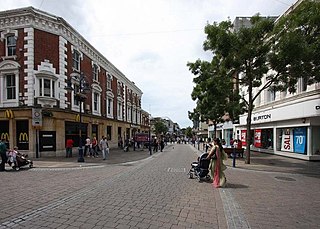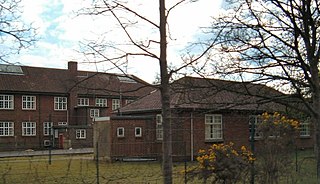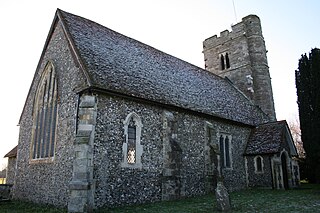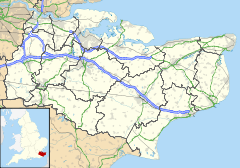
Gravesend is an ancient town in northwest Kent, England, situated 21 miles (35 km) east-southeast of Charing Cross on the south bank of the Thames Estuary and opposite Tilbury in Essex. Located in the diocese of Rochester, it is the administrative centre of the Borough of Gravesham.

The Borough of Dartford is a local government district in the north-west of the county of Kent, England. Its council is based in the town of Dartford. It is part of the contiguous London urban area. It borders the borough of Gravesham to the east, Sevenoaks District to the south, the London Borough of Bexley to the west, and the Thurrock unitary authority in Essex to the north, across the River Thames. The borough was formed on 1 April 1974 by the merger of the Municipal Borough of Dartford, the Swanscombe Urban District, and part of the Dartford Rural District. According to the 2011 Census, its population was 97,365.

Northfleet is a town in the borough of Gravesham in Kent, England. It is located immediately west of Gravesend, and on the border with the Borough of Dartford. Northfleet has its own railway station on the North Kent Line, just east of Ebbsfleet International railway station on the High Speed 1 line.

Meopham is a large linear village and civil parish in the Borough of Gravesham in Kent, England, lying to the south of Gravesend. The parish covers 6.5 square miles (17 km2), and comprises two villages and two smaller settlements; it has a population of 6,427 increasing slightly to 6,722 at the 2011 census. Meopham is sometimes described as the longest settlement in England although others such as Brinkworth, Wiltshire make the same claim. Meopham is one of the longest linear settlements in Europe, being 7 miles (11 km) in length.

Wrotham is a village on the Pilgrims' Way in Kent, England, at the foot of the North Downs. It is 1 mile (1.6 km) north of Borough Green and approximately 5 miles (8 km) east of Sevenoaks. It is between the M20 and M26 motorways.

Queensland University Regiment (QUR) is a training unit of the Australian Army Reserve. Based in Queensland, the regiment is currently assigned to the 8th Brigade. The regiment's history can be traced back to 1932 when the University Rifles was formed. During World War II, the regiment's predecessor unit did not serve overseas, but many of its personnel were deployed as part of the 7th Brigade or within units of the Second Australian Imperial Force. After the war, the regiment was formed under its current designation. Since then, its size has fluctuated as its role has changed. Currently, it is responsible for providing training for Reserve officer cadets, officers and soldiers.

Sir Sydney Hedley Waterlow, 1st Baronet was an English philanthropist and Liberal Party politician, principally remembered for donating Waterlow Park to the public as "a garden for the gardenless".

Camp Blanding Joint Training Center is the primary military reservation and training base for the Florida National Guard, both the Florida Army National Guard and certain non-flying activities of the Florida Air National Guard. The installation is located in Clay County, Florida near the city of Starke. The site measures approximately 73,000 acres (300 km2) and includes Kingsley Lake. It also hosts other Reserve, Army National Guard, Air National Guard, and some Active Component training for the U.S. Armed Forces.
The following is a list of recreational walks in Kent, England.

Istead Rise is a village in the borough of Gravesham in Kent, England, 3 miles (5 km) south of Gravesend. It had a population of 3,437 at the 2011 Census.

New Barn is a compact residential area surrounded by open fields which lies four miles southwest of Gravesend in Kent, England. It is in the local government district of Dartford. The villages of New Barn and Longfield are within and give their names to the civil parish of Longfield and New Barn. New Barn is larger in population than Longfield, although has little in the way of services, being a recent development and purely residential in nature

Singlewell or Ifield is the name given to the area south of Gravesend in Kent, England.

Dode was a village in England that was wiped out by the Black Death in 1349. All that remains is the deconsecrated church, which was rebuilt in the 1990s.

Trosley Country Park is in Trottiscliffe, near Vigo, in Kent, England. Once part of a large woodland estate then after many changes, it was passed to Kent County Council, who turned it into a large country park.

Camer Country Park is in Meopham, in Kent, England. It is a former estate landscape, with grassland and woodland.

Bordon and Longmoor Military Camps were British Army training camps close to the A3 and A325 roads in and around the settlements of Bordon, Longmoor, Liss and Liphook in Hampshire, England. The main street of the Longmoor part of the camp is built on an ancient Roman road, the Chichester to Silchester Way, while the village of Greatham lies to the west. The combined camp and training area covered 1,783 hectares of wooded areas, heath, wetlands and hard standings.

Nurstead is a locality, ecclesiastical parish and former civil parish situated 3 miles south of Gravesend and ½ a mile north of Meopham, Kent, England.

The Army Reserve Officers' Training Corps (AROTC) is the United States Army component of the Reserve Officers' Training Corps. It is the largest Reserve Officer Training Corps (ROTC) program which is a group of college and university-based officer training programs for training commissioned officers for the United States Army and its reserves components: the Army Reserves and the Army National Guard. There are 30,000+ Army ROTC cadets enrolled in 274 ROTC programs at major universities throughout the United States.

















